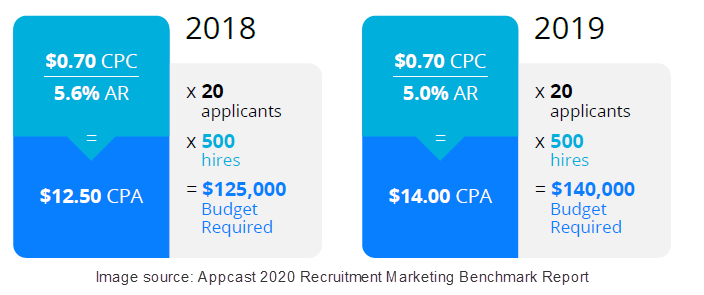Hiring top talent these days is tough, and if you do it wrong, you could end up breaking the bank. Not only is the cost to onboard and retain talent expensive, but so is the cost of promoting your job ads on the Internet.
Programmatic job advertising software company Appcast recently released its annual benchmarking report, and this year’s focus makes the case for implementing a mobile application process. The 2020 Recruitment Marketing Benchmark Report helps hiring professionals understand how, when, and where to reach targeted jobseekers and, based on geographical and market factors, how much money you may need to spend on job ads in order to reach them.
Key findings from the report include:
- Average costs per click (CPCs) are flat (overall, only increasing to $0.71 in 2019 from $0.70 in 2018) and have been relatively the same over the 4 years Appcast has produced its report. Additionally, apply rates (ARs) have dropped, meaning an employer’s cost per applicant has increased. In other words, you are paying more to get less.
- Mobile apply traffic continues to increase year over year, highlighting the importance of building an apply process that is aligned with changing jobseeker behaviors and expectations.
- Understanding the timing (days of the week or month) of when most employers bid for candidates in the market may allow you to adjust or pace your bids to align to those times when there is less competition.
With these key findings in mind, let’s break down the report even further so you understand how to better convert jobseekers into job applicants.
You’re Spending More for Candidates
Gone are the days of classified job ads; instead, jobseekers are turning to the Internet to search and apply for open positions. With that in mind, it may seem like posting job ads to the Internet would be relatively cheaper compared with print, but that is not the case.
“Over the course of our research, we’ve noticed a direct correlation between the unemployment rate and apply rate. As a result, this means you pay more for candidates,” finds the Appcast report. “Simply put, a drop in [AR] means that you get fewer candidates from the same amount of clicks, meaning your cost per application (CPA) increases.”
Appcast offers this formula to drive this point home: budget required = CPA x # of applicants needed per job x # of hires to make. If you aren’t good at math, or if you’re better with visuals, the graphic below highlights how the CPA is increasing over time:
As the cost continues to increase, making the right hire the first time around is becoming more crucial. To get ahead of your competition, Appcast suggests changing your recruitment advertising and offers these three suggestions:
- Increase your CPC bids.
- Buy media on a CPA basis to mitigate the risk of poor conversion rates from click to apply.
- Make changes to your apply process to improve your conversion rate.
While we can’t adjust your budgets for you, we can offer some tips for changing your processes.
Changing Your Apply Process for Better Conversions
As Appcast suggested, you must change the application process to get better conversions, and according to its research, it starts with the way candidates find and apply for your jobs.
Timing. When a candidate searches and applies for open positions is vital for cost-savings, and that starts with understanding when jobseekers look for new jobs. According to Appcast research, Monday continues to be the most popular day for desktop applies.
However, as with most things, there is a caveat to the best day for applies, and that’s when you factor in the mobile users. For mobile users, the best day of the week for applies is Saturday. Appcast found that when jobseekers apply on Monday and Tuesday, during the day, they use desktop computers, but during the evening, they use mobile devices.
Appcast pro tip: “First, make sure you know your audience. If you are hiring for an industry or function that you know are more active on mobile, then sponsor your jobs for evenings and weekends. The data suggests your ads will perform well.”
“If using a programmatic partner, ensure you’re bidding down or setting your bids lower on days of the week when your jobs are likely to get less visibility. This will ensure you’re not wasting budget on days of the week with low candidate activity.”
Job titles. As we know, a job description can make or break your number of applies, and it all starts with the job title. According to Appcast research, in 2019, job ads with titles between 1 and 3 words had the highest average volume of clicks (8.3) and the highest apply rate at 7.1%.
Impressively, job titles that were just 1 word had an apply rate of 9.9%. If you’re able to whittle down your job titles to just 1 word, you will see better conversion rates, but we understand that not all jobs can be summed up in 1 word.
Appcast pro tip. “Keep titles simple, clear, and free of jargon. This trend has been consistent year over year—jobs with shorter titles perform best.” Chloe Bennet, an HR Advisor, shares these other tips to nailing the job title:
“Be specific. Include what the actual job is, not just the company name or sector. Be concise, as well—a long title will turn people off. Don’t include things like pay rates, jokes, or colloquial terms in the title. Keep it 100% professional.”
Finding talent is tough and could get rather expensive if you don’t put the proper strategies to recruit the modern jobseeker in place. Keep the above information in mind when drafting and posting Internet job ads. To learn more about the 2020 Recruitment Marketing Benchmark Report, click here.
For even more insights into creating the perfect job post, join Katrina Kibben of Three Ears Media for the RecruitCon 2020 Spring Learning Lab session, “Why Your Job Posts Aren’t Working and the 4-Step Formula for Changing That,” on May 14–15, 2020, in Denver, Colorado.



